As part of the Hyper Building B Services Team, our Integrative Modeling session focuses on developing a strategic approach to podium-level services. This initial stage revolves around conceptualizing and allocating key functions across different building levels.
Key Spatial Allocations:
- Podium Level: Healthcare and essential services
- Mid-Level: Educational facilities
- Transition Zone: Retail and urban interaction
- Strategic Green Spaces: Designed for relaxation and community engagement
- Upper Levels: Wellness, recreation, and fitness
- Roof & Sky Bridges: Fitness areas, parks, and vertical circulation connecting towers
This preliminary discussion serves as the foundation for refining an integrated approach to building services, ensuring a seamless connection between function, sustainability, and user experience.
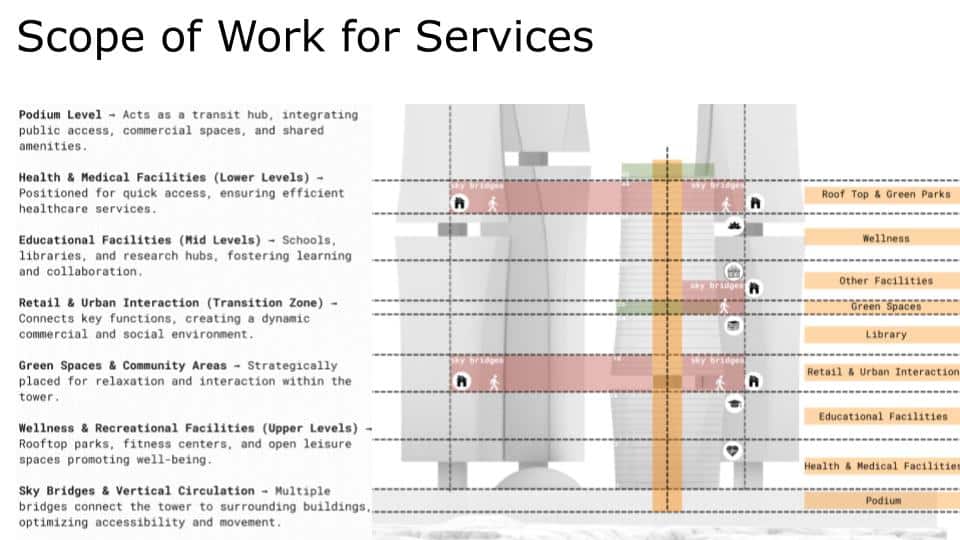
In shaping the Hyper Building B, our approach to design and circulation is centered on seamless integration, efficiency, and user experience. The towers are strategically divided into four vertical zones, ensuring optimized connectivity and functionality across different levels:
Sky bridges and vertical circulation cores strategically connect these zones, ensuring fluid movement while reinforcing the hyper-connectivity of the towers. This zoning strategy not only enhances spatial efficiency but also fosters a layered architectural narrative, promoting interaction, accessibility, and sustainability.
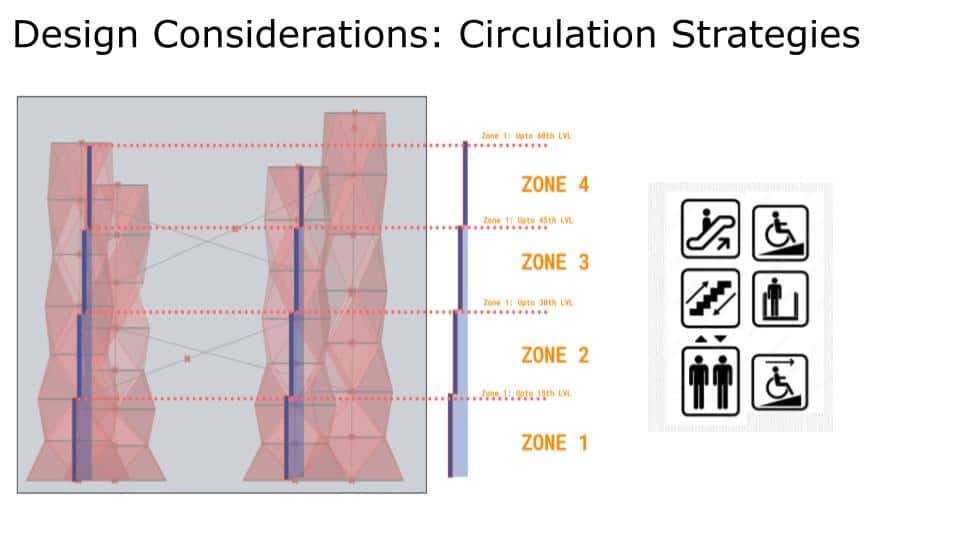
Our circulation strategy for the podium level focuses on optimizing vertical, horizontal, and diagonal movement to ensure seamless connectivity and efficiency. Vertical circulation elements, such as elevators, stairs, and escalators, are strategically highlighted to facilitate smooth transitions between floors. Horizontal movement is streamlined through an extensive network of hallways and corridors, ensuring intuitive wayfinding. Additionally, diagonal ramps and walkators, designed in a fluid infinity loop, enhance accessibility and movement efficiency across the podium. By analyzing average transit speeds, we have optimized circulation to achieve maximum efficiency for seamless floor-to-floor movement, reinforcing a well-integrated spatial experience.
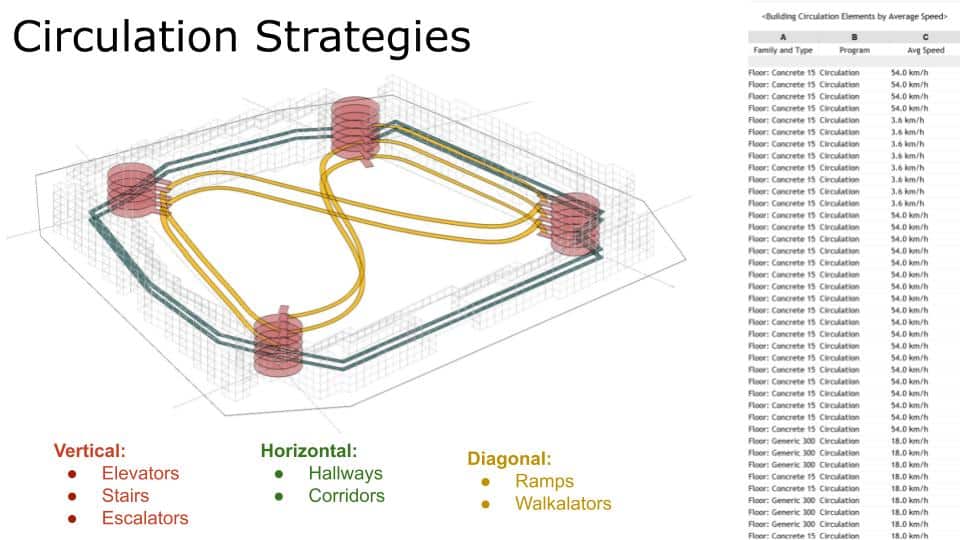
Optimized Circulation Strategies for Service Efficiency
A well-planned circulation strategy is crucial for enhancing efficiency, accessibility, and user experience within a high-density, multi-functional development like Hyper Building B. Our service-oriented circulation strategy is structured around four key functional areas—Education, Shopping & Food, Wellness, and Urban Interaction—across Towers A, B, C, and D.
By analyzing Service Key Performance Indicators (KPIs) and travel time per function, we have mapped out precise movement patterns across all floors. This includes:
- Strategic Elevator Placement – Ensuring optimized vertical transport to minimize congestion and wait times.
- Dedicated Exit Routes – Allocating efficient pathways for seamless navigation between zones.
- Floor-Specific Service Integration – Aligning circulation pathways with specific user needs at each level.
This data-driven circulation approach significantly enhances spatial fluidity, reduces transit time, and improves operational efficiency, making movement within the towers more intuitive and effective. By integrating circulation with functional demands, we ensure that the built environment adds value through enhanced mobility, optimized service distribution, and a seamless urban experience.
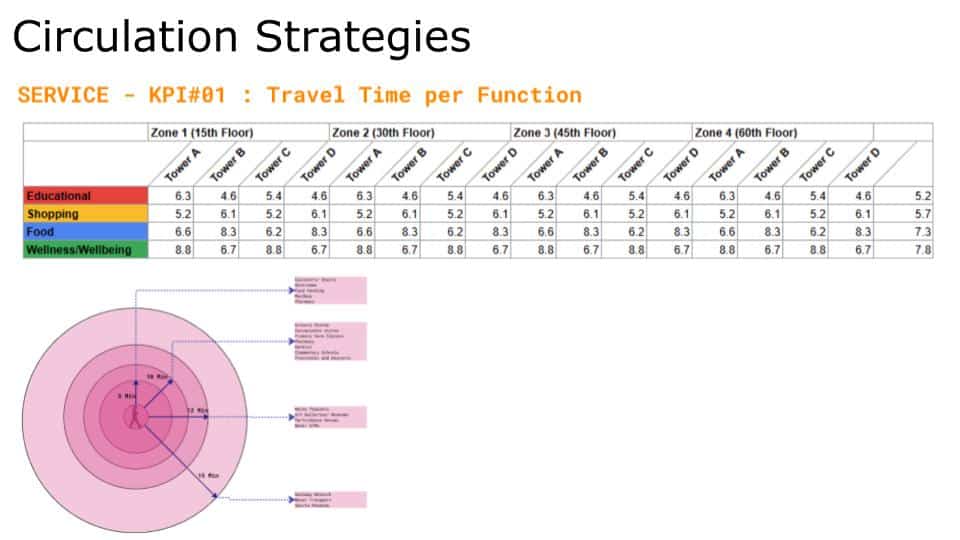
The adaptive roof panel system for Hyper Building B is designed as a triangular tessellated structure, seamlessly integrated using Rhino, Grasshopper, and Revit iNSIDE. Developed through an advanced parametric workflow, the roof panels were first scripted in Grasshopper, allowing for precise control over geometry and adaptability. The generated panels were then processed through Rhino Inside Revit, transforming them into an adaptive family system within Revit for seamless integration into the overall building model.
This data-driven approach ensures structural efficiency, design flexibility, and seamless coordination between computational design and BIM workflows, enhancing both the aesthetic and functional aspects of the architectural envelope.
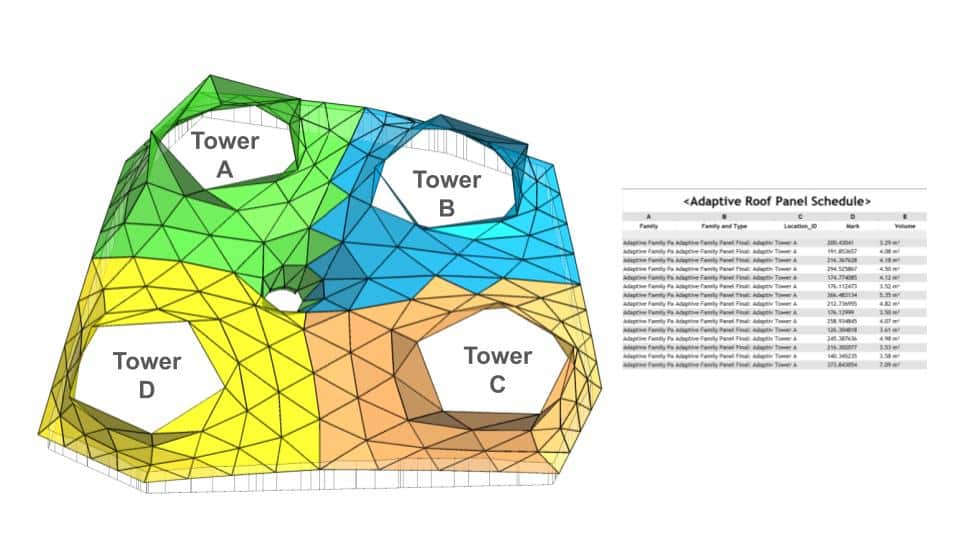
The podium design of Hyper Building B is shaped through a rigorous KPI-driven approach, integrating building volume analysis, workspace allocation, and sustainability benchmarks. Designed as a workspace-centric environment, the podium optimizes spatial efficiency while responding to global and local standards.
A key aspect of the design is its focus on green space per person, aligning with U.S. Green Building Council recommendations and Tokyo’s urban green space average of 4.35 sqm per person. To enhance environmental quality and user well-being, a comprehensive green roof has been integrated atop the podium, maximizing open space while maintaining the urban density.
Visually, the podium structure follows a voxel-based design strategy, where the building mass is conceived as modular cubes, ensuring adaptability and efficient spatial distribution. This data-driven and parametric approach enhances both functionality and environmental performance, reinforcing a holistic vision for sustainable urban design.
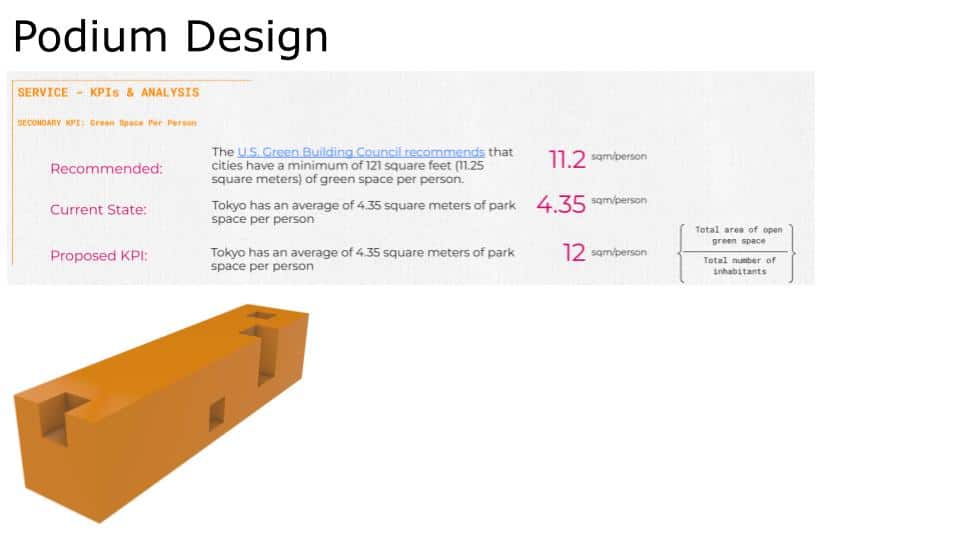
The podium design of Hyper Building B is a fully parametric model, developed through Grasshopper and Rhino Inside Revit, ensuring precision, flexibility, and seamless integration into the BIM workflow.
The voxel-based massing strategy was scripted in Grasshopper, where each modular unit was dynamically generated based on spatial efficiency, programmatic needs, and KPI-driven analysis. Through Rhino Inside, the voxelized form was translated into Revit, where cubicle allocations, functional zoning, and area calculations were systematically refined. The entire podium, including workspace distribution, green roof integration, and circulation pathways, was algorithmically modeled, allowing for real-time adaptability and data-driven decision-making.
This computational approach not only optimizes the building’s form and functionality but also enhances its efficiency and environmental performance, ensuring a highly responsive and integrated urban workspace.
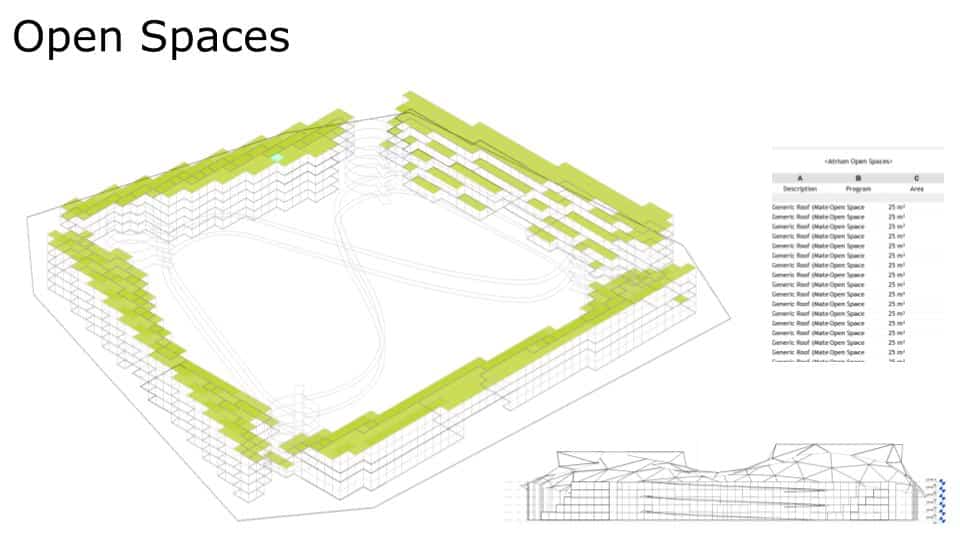
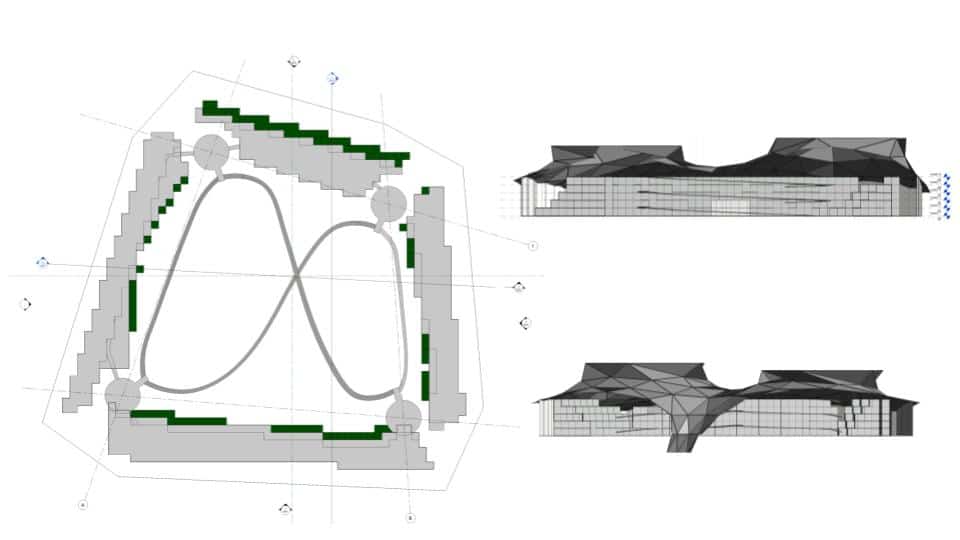
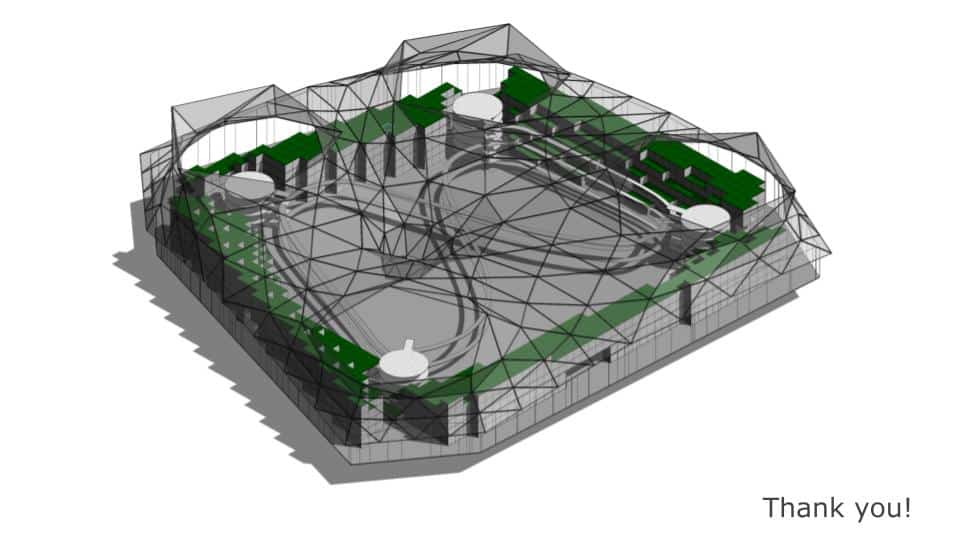
The final iteration of Hyper Building B showcases the fully assembled podium roof and floors, integrating all panel types with precision. The total number of each panel type has been validated, ensuring that the design aligns seamlessly with both performance and aesthetic objectives.
Tools and Workflow
To execute this integrative roof and podium floor strategy, we employed a computational workflow combining multiple tools:
- Grasshopper – Used to generate and subdivide the facade geometry.
- Rhino Inside Revit – Enabled seamless data exchange and adaptive panel placement within the BIM environment.
- Revit – Captured panel placement, refined design iterations, and ensured constructability.
- Custom Parameters – Incorporated for structural integrity, environmental performance, and material efficiency.
- Speckle – Facilitated real-time collaboration and data management, ensuring accuracy across digital models.
This parametric workflow allowed us to automate panel allocation, optimize placement, and maintain design coherence, ensuring that the facade meets both technical requirements and architectural intent.

